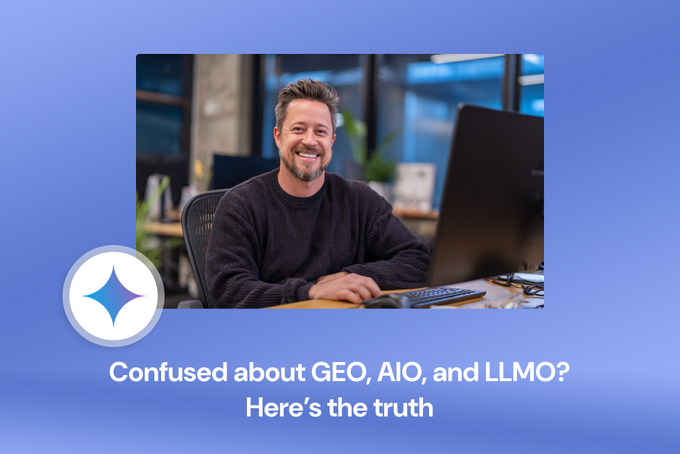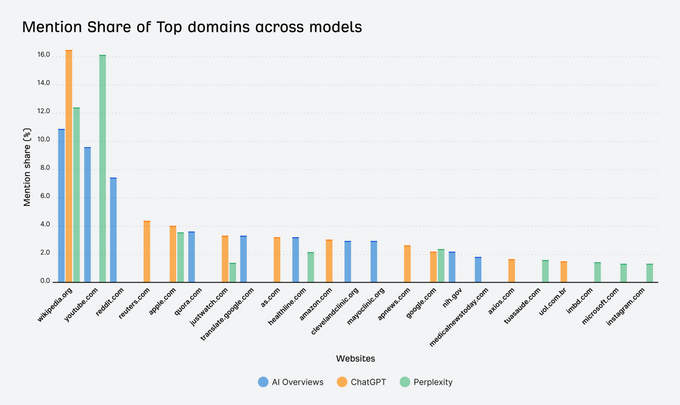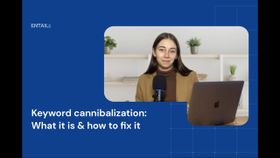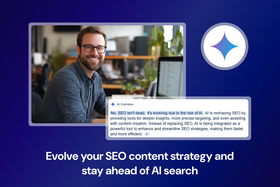GEO vs. AIO vs. LLMO: Is it all just the same strategy?
GEO, AIO, and LLMO refer to the same thing: optimizing content for AI search. This article breaks down what these terms mean, how they connect to SEO, and the strategies you need to show up in AI answers.
Updated August 19, 2025

With AI reshaping search, new terms like generative engine optimization (GEO), AI optimization (AIO), and large language model optimization (LLMO) have popped up to describe the process of optimizing content for AI platforms.
But is there a difference between these terms? The simple answer is no. They all refer to the same idea: adapting SEO to work in a world where AI is at the forefront of search.
Key takeaways
- GEO, AIO, and LLMO all refer to the same thing—optimizing for AI search.
- GEO is the most commonly used term.
- AI optimization builds on traditional SEO but requires new tactics tailored to how LLMs read and surface content.
- Improve LLM visibility by building a strong brand and creating helpful, well-structured content.
What's the difference between GEO, AIO, and LLMO?
GEO, AIO, and LLMO are essentially three different names for the same thing: optimizing content so it can be surfaced, summarized, or cited by AI search engines like ChatGPT, Perplexity, or Google’s Gemini, AI Overviews, and AI Mode.
The goal is to make your content clear, trustworthy, and structured in a way that large language models can easily understand and use.
» Explore the differences between ChatGPT search and Google.
Which term should I use?
GEO is the term most commonly used in my circle, so that's the one I prefer.
In terms of overall popularity, GEO appears to lead based on recent search data from Semrush:
| Term | Global search volume | Keyword difficulty |
|---|---|---|
| Generative engine optimization | 2,300 | 62% |
| LLMO | 1,900 | 43% |
| AI optimization | 1,300 | 20% |
Note: I’ve excluded search data for “GEO” and “AIO,” since both already exist in very different contexts. These terms tend to return mixed or unrelated results, making them less reliable for tracking actual interest in AI optimization.
That said, I'll be using "GEO" for the rest of the article.
» Book a consultation to get an SEO strategy built for AI search.
Is GEO different from SEO?
Yes and no. GEO is built on the foundation of SEO, but it takes it a step further.
SEO has always been about making content accessible to crawlers and helpful to users. GEO adds a new layer: making content understandable to LLMs that rely on context, structured data, and authority signals to generate answers.
As search engines integrate AI directly into the SERP, GEO and SEO are becoming two sides of the same coin. It’s still SEO at its core, but with a wider scope, new tactics, and some specializations in how we structure content.
READ MORE: Should you change your SEO strategy because of AI?
7 strategies to improve visibility in AI search
If you want your content to show up in AI-generated answers, you need to go beyond traditional SEO. These strategies help ensure your brand and content are discoverable, trustworthy, and usable.
1. Build a recognizable brand
AI models rely on well-known, frequently mentioned sources—so your brand needs to be one of them.
Extra points if you appear on platforms where your audience spends time. Make sure to show up on social media (LinkedIn, TikTok, YouTube, Instagram), community websites (Reddit, Quora, Medium, Wikipedia), and renowned and niche media outlets, as AI often uses their content in their training models.
Source: Ahrefs
Repurpose your content across formats and channels while keeping your messaging clear and consistent. Mentions can carry as much weight as backlinks in the AI era.
2. Use multiple formats
AI pulls from all kinds of media to surface information, including videos, podcasts, charts, infographics, and even multilingual content. So, you want to control your messaging across all these assets and diversify as much as possible.
» Learn how to create social media videos for your brand
3. Structure content for AI readability
You need to ensure your content is easy for LLMs to parse. Here’s how to structure content in an AI-friendly way:
- Use clear, descriptive headings and subheadings
- Start each paragraph with a direct answer, then expand with supporting details
- Break up content using bullet points, numbered lists, tables, and short paragraphs
- Include concise summaries and FAQs
- Write in unambiguous language and avoid overly complex or vague phrasing
- Make sure each section can stand alone and still make sense
This helps AI models extract relevant information more easily, increasing your chances of being cited.
SEE ALSO: How to optimize for zero-click searches
4. Cover relevant topics comprehensively
LLMs look for content that’s semantically rich and contextually complete. Think in topic clusters, not isolated keywords. Cover the “what,” “why,” “how,” and “what’s next” in one place.
5. Create original expert content
Your content must present facts clearly, avoid speculation, and include high-quality sources. LLMs may not follow Google’s E-E-A-T (Experience, Expertise, Authoritativeness, Trustworthiness) content requirements exactly, but they still value factual, attributable, and verifiable content. Fresh content is also used as a reference check against training data.
» Find out how to create authentic expert content
6. Ensure crawlability and indexability
Make sure your site is technically accessible. Avoid relying on JavaScript, minimize page load times, and eliminate UX blockers. If a crawler or AI tool can’t easily access your content, it won’t be used.
7. Use structured data
Schema markup helps LLMs better classify and extract information by highlighting key elements in your content. Structured data gives LLMs additional context and makes it highly digestible. Without it, your content might be present online, but it's much harder for AI to recognize its full value and use it effectively.
READ MORE: Are llms.txt files the missing link in AI-powered SEO?
Looking ahead
AI search is still new, and no one has it figured out yet. There aren’t any real tools built for GEO, and even the experts are still learning what works.
AI is also easily exploitable with black hat techniques, which leaves room for risky shortcuts. But as AI matures, so will the tactics. The best thing you can do is focus on creating helpful, high-quality content that stands the test of both search engines and LLMs.
» Need help optimizing for AI search? Talk to an SEO expert.






